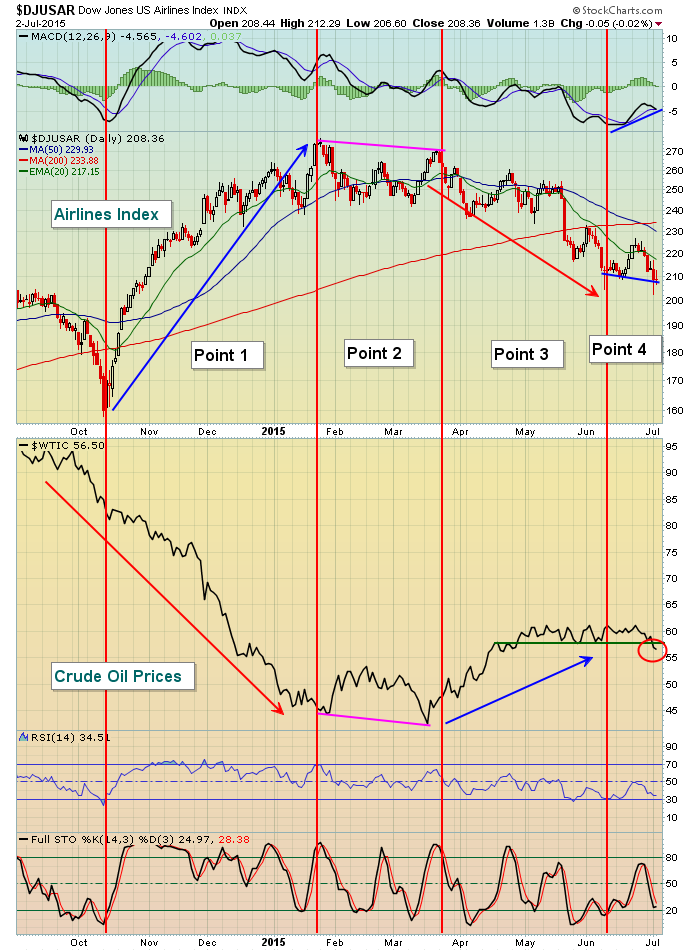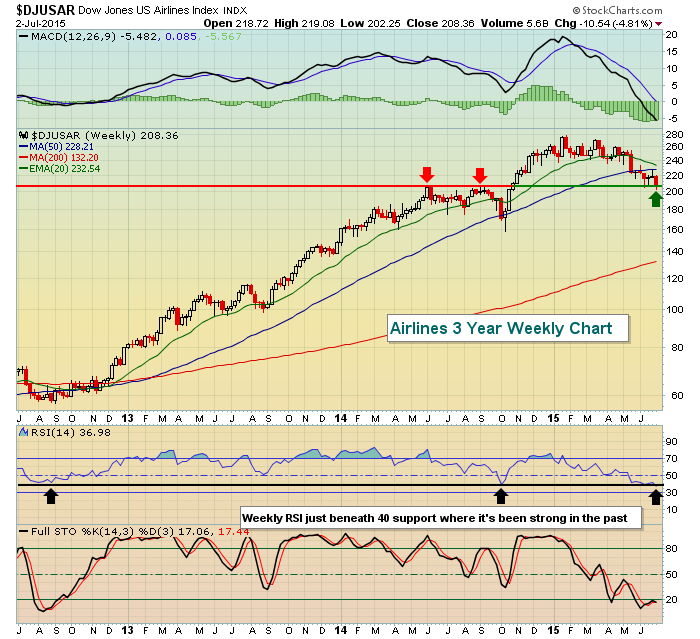Market rotation is the key during every bull market. Indices begin to fall apart when rotation fails and money leaves many aggressive areas and doesn't move to others. But our major indices stay on course so long as market rotation continues and thus far that's what we've witnessed. Technology has been quite weak of late with the XLK falling 3.39% over the past month. The overall market struggled as well in June, but there have been bright spots to keep prices above key technical levels. So while semiconductors ($DJUSSC) and telecom equipment ($DJUSCT) companies delivered a blow to technology last month, we've seen footwear ($DJUSFT) and home construction ($DJUSHB) stocks soaring to help offset the technology weakness. And remember the awful gambling index ($DJUSCA)? Remember how weak that index was a couple months ago as we prepared for the Kentucky Derby that first weekend in May? We've begun to see life there after a long-term divergence printed on the weekly chart. That May 2nd article, "Place Your Wagers Please" highlighted the woes of the gambling index but provided hope because long-term support was being tested as selling momentum (ie, long-term positive divergence) waned.
Also, we've seen money rotate towards financials as the recent rise in 10 year treasury yields ($TNX) has created a perfect storm for banks and insurance companies. The steepening yield curve is generally a positive development for banks as they can charge more for loans, expanding their net interest margin. The key here is WHY are yields rising? If it's in anticipation of a strengthening economy, it should continue to aid the prices of bank stocks.
Again, it's all about rotation in a bull market. So long as the money coming out of one aggressive group finds a home in another, the bull market lives on. That's what I'm seeing so - technically - I remain on the bullish side. I do realize that the summer is not the best time for stock performance, however, so my enthusiasm is tempered.
That brings me to airlines ($DJUSAR).
Transportation stocks, darlings of 2014, are one of the worst areas of the stock market in 2015. In 2014, airline stocks rose 84%. In 2015, they've fallen 18%. In 2014, railroad stocks rose 29%. In 2014, they've fallen 18%. In 2014, truckers rose 25%. In 2014, they've fallen 12%. If this isn't rotation, I'm not sure what is.
This is simply proof that today's hot stocks and indices are not likely to be tomorrow's and you have to bear this in mind when selecting stocks and/or ETFs to trade. Airlines are at a rather interesting juncture. They benefited mightily from the freefall in crude oil prices in the second half of 2014. But crude oil has stabilized and risen in 2015, actually rising 50% from late March to early May. That's hurt airline stocks and it's obvious from the following chart:
Point 1 shows a three month period of time in late 2014 and early 2015 where crude oil prices collapsed, sending airline stocks through the stratosphere. Please note, however, that long-term negative divergences printed on these late 2014 highs and that sign of slowing momentum then took its toll in 2015. The interesting thing about Point 2 is that crude oil made a fresh low, but the airline index did NOT make a new high - again a sign of slowing momentum or weakness. Point 3 shows airline stocks trending lower and lower as crude oil prices rebounded. Point 4 is where it begins to get really interesting. A positive divergence has now emerged as crude oil prices have failed to hold onto recent price support from May. If crude oil prices are rolling over and heading back down, it would certainly add to reasons to own airline stocks, if the positive divergence wasn't enough to sway you.
There are two other reasons to like airline stocks.
First, the weekly chart shows that the current price is testing significant price support. Take a look:
Second, the bearish historical tendencies of June are now behind the industry group. Over the past 16 years, airline stocks have risen just three times during the month of June. That 19% success rate in June clearly places it last among the calendar months and as we move further and further into the calendar year, airlines tend to fly higher. Check out this seasonality chart:

For a group looking to get off the ground, those historically bullish October returns can't get here soon enough!
Happy trading!
Tom








